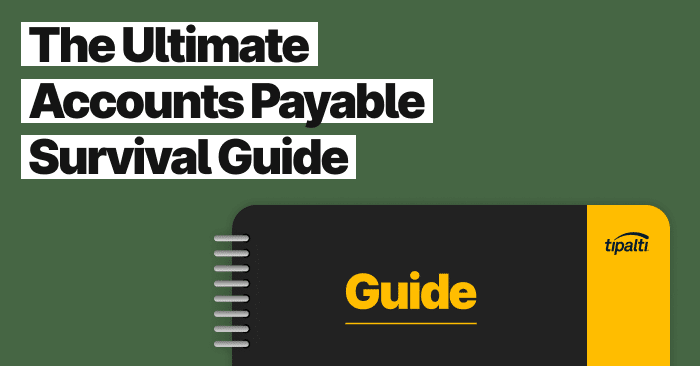
See how forward-thinking finance teams are future-proofing their organizations through AP automation.
Fill out the form to get your free eBook.

Today, the finance function has more responsibilities than ever. In high-growth businesses, every operation—both front and back-office—is inexplicably tied to investment versus reward. To survive the uncharted road ahead, the modern, forward-thinking finance team has to future-proof their organization for success. Download the guide to discover: – The untamed wilderness of finance – How to forge an accounts payable path – How to strategize your next move – The ultimate accounts payable survival tool – How real-life survivalists scaled their businesses
Automation can revolutionize the accounts payable process; a business simply needs to find the right tool. There are many solutions out there, so when it’s time to start looking, which platform fits best?
Here are a few factors to consider during the search:
User-Friendly Interface
A simple interface means a smooth learning curve and a quicker onboarding process. The dashboard should be neat, uncluttered, and help staff spot essential aspects of accounting in seconds.
Built-in functions make it easier for staff to manage accounts. It should be easy to navigate and enable a business to complete tasks quickly.
Robust Data Security
AP automation software guards sensitive financial data. Select apps from well-known brands that provide two-factor authentication, encryption, and secure communication.
Automation
Automation enables AP teams to accomplish more in less time. At the billing and invoicing level, a business can set up recurring transactions, send out payment reminders, and auto-charge customer credit cards.
At the procurement level, automation facilitates the invoice process with three-way matching, touchless purchase orders, and electronic data interchange (EDI) (think e-invoices).
Optical character recognition (OCR) automatically captures invoice data as it comes in. Auto-scan is a paperless feature that can turn receipt data into transactions with minimal effort.
Multiple Payment Options
Look for an AP automation solution that provides customers a safe means of paying online. Integrated payment gateways offer a variety of payment options, like:
- Credit cards
- Debit cards
- Online bank transfers
As soon as the payment goes through the gateway, the corresponding invoice status is updated in the system.
There are many payment gateways to choose from, and each one will charge different transaction fees.
Dynamic Integrations
Integrations make a tech stack powerful and more flexible. The AP department must be able to work with different platforms without leaving the dashboard. Third-party apps modifications should be updated in the system.
Accounting software should integrate with the ERP system and third-party apps like:
- Inventory management
- Analytics and reporting
- Project management tools
- Customer relationship management (CRM)
Accounts Receivable Functionality
Accounting systems enable a business to record both accounts payable and accounts receivable.
Accounting software includes tasks like:
- Professional invoices
- Data capture
- Collect online payments
The software will display which customers have yet to pay and how much they owe. It should help keep tabs on payables, like vendor bills and operating expenses, and send automatic reminders to ensure people pay on time.
Cash-Based and Accrual Accounting
The chosen AP solution has AI to enable a business to toggle between different accounting methods.
A small business mainly records transactions based on the inflow and outflow of cash. In this case, the cash accounting method works best.
Larger businesses that buy and sell on credit (and record accounts payable and receivable) should consider the accrual method.
Many companies start with the cash method of accounting and switch to the accrual method later on. AP software provides options between the two.
Project-Based Billing
Businesses that work with clients hourly require accounting software that handles project-based billing. Regulations allow staff to bill based on time for individual tasks.
Timesheets can then be converted into invoices. To prevent billing errors, the system enables timesheet approval before creating the invoice.
Reporting and Analytics
A business seeks accounting software capable of generating a variety of financial reports, both standard, and custom. Data includes:
- Income statements
- Balance sheets
- Cash flow statements
The software helps generate reports for different accounting departments, such as:
- Accounts payable and receivable
- Projects
- Inventory
- Taxes
This data can tell a business how well it’s performing in specific areas and where there’s room to improve.
Role-Based Permissions
The best accounting solutions on the market allow a company to give employees role-based access to specific modules.
For example, all staff can access timesheets to log hours but cannot access reporting and sensitive data. The AP solution provides selective access that limits essential information from unauthorized personnel.
Bank Reconciliation
The AP program automatically fetches bank statements. Set custom criteria and bank rules that will match and categorize any imported statements in seconds.
Automation avoids bottlenecks that occur from mistakes during manual entry.
Taxes
The chosen AP solution includes calculated tax liability abilities. Being tax-ready is critical for surprise audits.
AP software should be able to perform tax functions like:
- Multiple tax rates
- Tax liability
- Tax reports
- Compliance
Mobility
The AP platform offers mobile, cloud-based features for flexible access at all times. Run the entire accounting process instantly, on the road.
Customer Support
Automating invoice management should always include a detailed onboarding process and answer questions as the user advances. Choose an AP solution that offers complete customer service, around the clock.
Pricing
AP software brands base different price points on the features offered. Although specific plans may cater best to business needs, there are some universal pricing standards that every organization should look for when sourcing AP platforms.
Here are a few options:
- Free trial
- Includes maintenance and support fees
- Low implementation cost (or none at all)
- Same price for multiple users
- No extra charges for basic features
Find an AP tool that offers a flat fee rather than a price per user. Flat fees provide the best cost savings across the board.
